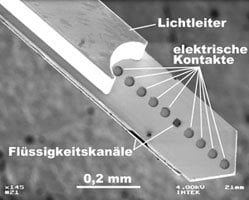A light switch inside the brain.
Activating and deactivating individual nerve cells in the brain is something many neuroscientists wish they could do, as it would help them to better understand how the brain works. Scientists in Freiburg and Basel, Switzerland, have developed an implant that is able to genetically modify specific nerve cells, control them with light stimuli, and measure their electrical activity all at the same time. This novel 3-in-1 tool paves the way for completely new experiments in neurobiology.
Birthe Rubehn and her colleagues from the Department of Microsystems Engineering (IMTEK) and the Bernstein Center of the University of Freiburg as well as the Friedrich Miescher Institute for Biomedical Research in Basel describe the prototype of their implant in the journal Lab on a Chip. They report that initial experiments in which they implanted prototypes into mice were successful. The team was able to influence the activity of nerve cells in the brain in a controlled manner by means of laser light pulses.

The team used an innovative genetic technique that brings nerve cells to change their activity by shining light of different colors onto them. In optogenetics, genes from certain species of algae are inserted into the genome of another organism, for instance a mouse. The genes lead to the inclusion of light-sensitive pores for electrically charged particles into a nerve cell’s membrane. These additional openings allow neuroscientists to control the cells’ electrical activity.
However, only the new implant from Freiburg and Basel makes this principle actually practicable. The device, at its tip only a quarter of a millimeter wide and a tenth of a millimeter thick, was constructed on the basis of polymers, special plastics whose safety for implantation into the nervous system has been proven.
Contrary to probes developed so far, it is capable of injecting the substances necessary for genetic modification, emitting light for the stimulation of the nerve cells, and measuring the effect through various electrical contacts all at once.
Besides optimizing the technique for serial production, the scientists want to develop a second version whose injection channel dissolves over time, reducing the implant’s size even further.
Notes about this neurobiology research
Contact: Dr. Thomas Stieglitz – Laboratory for Biomedical Microtechnology in the Department of Microsystems Engineering – IMTEK
Source: University of Freiburg press release
Image Source: The neural probe image was adapted from the University of Freiburg press release. Image credited to IMTEK/University of Freiburg
Original Research: Abstract for “A polymer-based neural microimplant for optogenetic applications: design and first in vivo study” by Rubehn B., Wolff S.B.E., Tovote P., Lüthi A. and Stieglitz T. in Lab on a Chip, advance article first published on the web 03 Jan 2013, doi: 10.1039/C2LC40874K






